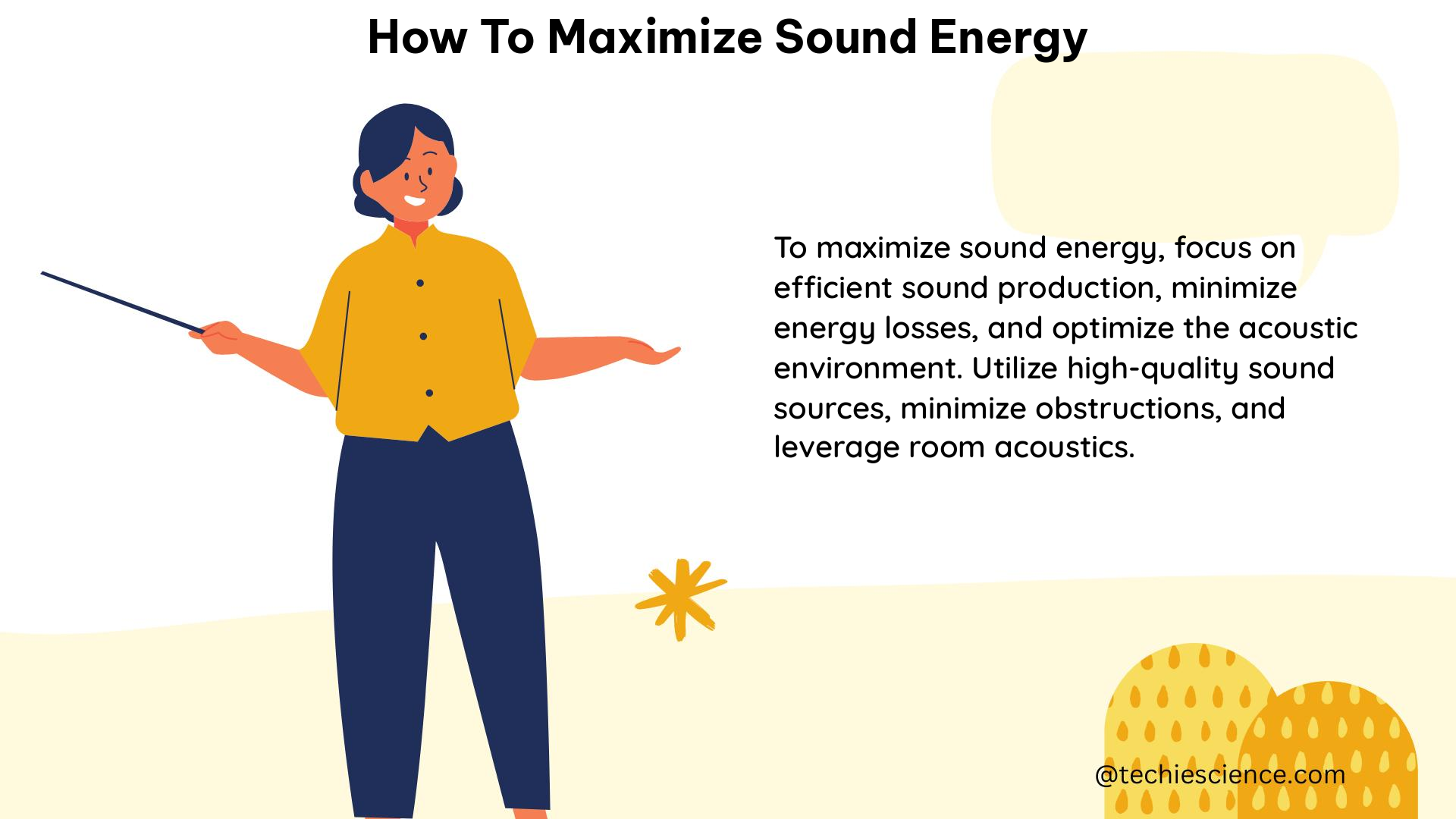Summary
Maximizing sound energy is a crucial aspect of various applications, from audio engineering to industrial processes. This comprehensive guide delves into the key factors that influence sound energy, including sound power, sound pressure level, directivity factor, and distance. By understanding the underlying principles and applying the right techniques, physics students can effectively harness and optimize sound energy for their specific needs.
Understanding Sound Power and Sound Pressure Level

Sound power, denoted as Lw, represents the total acoustical energy emitted by a sound source. It is an absolute value that is not affected by the environment and is measured in watts. The sound power level can be calculated using the formula:
Lw = 10 × log (P/P0)
Where:
– P is the sound power in watts
– P0 is the reference power of 10^-12 watts
On the other hand, sound pressure level, denoted as Lp, quantifies the strength of a given sound source in decibels (dB). Unlike sound power, sound pressure level varies with distance from the source and other environmental factors. It is measured using a sound pressure level meter and can be calculated using the formula:
Lp = 20 × log (p/p0)
Where:
– p is the sound pressure in Pascals (Pa)
– p0 is the reference sound pressure of 2 × 10^-5 Pa
The Role of Directivity Factor
The directivity factor, denoted as Q, is a measure of the spatial distribution of sound energy. It affects the relationship between sound power and sound pressure level. For a point source emitting sound uniformly in all directions in a free field, the directivity factor is Q = 1, and the relationship between sound power level and sound pressure level is given by the formula:
Lp = Lw – 20 × log r – 11 dB
Where:
– r is the distance from the sound source in meters
Maximizing Sound Energy
To maximize sound energy and achieve higher sound pressure levels, you can employ the following strategies:
-
Increase Sound Power: By increasing the sound power of a source, you can directly increase the sound pressure level. For example, a sound source with a sound power level of 90 dB will produce a sound pressure level of 78 dB at a distance of 1 meter in a free field with a directivity factor of Q = 1, compared to a sound source with a sound power level of 80 dB, which would produce a sound pressure level of 68 dB under the same conditions.
-
Reduce Distance to the Source: Decreasing the distance to the sound source by a factor of 2 will double the sound pressure level, assuming the sound power level and directivity factor remain constant. This is due to the inverse square law, which states that the sound pressure level decreases by 6 dB for every doubling of the distance from the source.
-
Adjust Directivity Factor: Manipulating the directivity factor can also impact the sound pressure level. For instance, adjusting the directivity factor to Q = 2 will reduce the sound pressure level by 3 dB at the same distance, assuming the sound power level remains constant.
Practical Considerations and Limitations
While maximizing sound energy is desirable in many applications, it is crucial to consider the impact on humans and the environment. Excessive sound levels can lead to hearing damage and other negative effects. Therefore, it is essential to ensure that sound levels are within acceptable limits and comply with relevant safety standards and regulations.
Additionally, the specific application and environment in which the sound is produced must be taken into account. Factors such as room acoustics, reflections, and absorption can significantly influence the relationship between sound power and sound pressure level, and must be carefully considered when attempting to maximize sound energy.
Conclusion
Maximizing sound energy is a complex and multifaceted challenge that requires a deep understanding of the underlying principles of acoustics. By mastering the concepts of sound power, sound pressure level, directivity factor, and distance, physics students can develop the skills and knowledge necessary to effectively harness and optimize sound energy for a wide range of applications.
Reference:
- Sound Energy: Definition, Characteristics, and Measurement Techniques
- Sound Power Level Measurement on a Notebook Computer
- Sound Measurements | Standards | Instrumentation | Techniques

The lambdageeks.com Core SME Team is a group of experienced subject matter experts from diverse scientific and technical fields including Physics, Chemistry, Technology,Electronics & Electrical Engineering, Automotive, Mechanical Engineering. Our team collaborates to create high-quality, well-researched articles on a wide range of science and technology topics for the lambdageeks.com website.
All Our Senior SME are having more than 7 Years of experience in the respective fields . They are either Working Industry Professionals or assocaited With different Universities. Refer Our Authors Page to get to know About our Core SMEs.